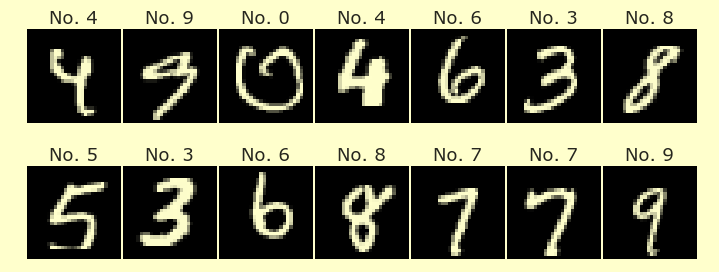Homework¶
This is a combined homework and worksheet, due at the usual worksheet time, Tuesday at 5pm. There are two goals of this homework.
Practice with gradient descent.
Look for overfitting in a neural network.
Gradient descent¶
The first part of the homework is about gradient descent. We will practice using gradient descent with the two-variable function \(f(x,y) = \frac{x^2}{4} + y^2\).
Here is an example of plotting contour lines using Matplotlib. (Adapted from Density and Contour Plots.)
%matplotlib inline
import matplotlib.pyplot as plt
import numpy as np
def f(x,y):
return (x**2)/4 + y**2
x = np.linspace(-5, 5, 50)
y = np.linspace(-5, 5, 40)
X, Y = np.meshgrid(x, y)
Z = f(X, Y)
plt.contour(X, Y, Z, 10, cmap='Greys');
Question 1¶
Try to make the plot look better:
Try adding
plt.style.use('???'), where???gets replaced by one of the choices fromplt.style.availableChange
cmap='Greys'to use a more interesting color map. You can find options in the Matplotlib documentation.
Question 2¶
Math 2D review: what is the relationship between gradient and contour lines? (When you perform the gradient descent below, you should look at the contour plot and make sure your directions seem correct.)
Question 3¶
Perform gradient descent by hand, starting at the initial point \((4,4)\) and using a learning rate of 0.01. Where do you land after one step? After two steps? Repeat this for a learning rate of 1, and a learning rate of 10. (Your answer for this question should be six total points: two points for each learning rate. Always begin at the point (4,4). You’ll definitely want to use the computer or a calculator.)
Reminders on gradient descent
The gradient at a point is a vector pointing in the direction of fastest increase (but we want decrease, so we want to move in the opposite direction).
We multiply the gradient by the learning rate to change the step size.
Here is the relevant part (starting at 8:17) from the 3Blue1Brown video:
General references.
Neural networks and overfitting¶
The second part of this homework is to practice with neural networks using the dataset for your final project.
Question 4¶
Build and train a neural network using the dataset for your final project. Clearly describe in a markdown cell what you are trying to compute. You can adapt the code we used for Handwritten digits or Fashion-MNIST or Spotify. Be sure there are only numeric columns in your input, like how we used X_train = df[numeric_cols] with the Spotify dataset.
Classification or Regression?
We have mostly done examples of training neural networks with classification problems, but see the Regression section from the end of class on Wednesday for an example of training a neural network for a regression problem.
An alternative is to add a column to your DataFrame which is something like, “True or False: this value is bigger than 8”, and then use classification on that new column. That is a way to create a classification problem out of quantitative data.
Question 5¶
Use the validation_split keyword argument when training the network. Show a plot of the training loss and the validation loss, like what we did in class on Wednesday.
Question 6¶
Based on the plot, do you think you were overfitting the data?
Question 7¶
In the gradient descent part, we were using gradient descent to try to find a minimum of a two-variable function. In this part, how many variables are there for the function we are trying to minimize? (Hint. Use model.summary(). You shouldn’t have to make any calculations yourself.)
